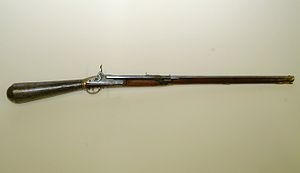Assuming Major Patrick Ferguson survives the Battle of Kings Mountain and the rest of the war what improvements might he have been able to make to his breech loading rifle design??
Minié ball - Does this have significant precursors or was it something that could have been developed easily at an earlier date??? It would speed up firing slightly - increase range and accuracy as the Minié ball expands to fill the barrel.
Mercury fulminate - developed in 1800 - used to fire muskets in 1820. More reliable than flint and powder and less effected by rain.
integrated cartridge - Around abut 1808.
Given optimum development how early could these inventions have all been made and brought together in a non ASB fashion? In time for the Peninsular?? for the 100 days??
Not to equip a whole army but for example to be used instead of the Baker Rifle - that sort of percentage distribution. )And yes - logistics would be an issue as nobody else uses anything similar)
ROF is likely to be 10 rounds a minute. Able to be loaded and fired from all positions including prone. Accurate and effective range likely to be something like the the Snider Pattern 1853 conversion.
Minié ball - Does this have significant precursors or was it something that could have been developed easily at an earlier date??? It would speed up firing slightly - increase range and accuracy as the Minié ball expands to fill the barrel.
Mercury fulminate - developed in 1800 - used to fire muskets in 1820. More reliable than flint and powder and less effected by rain.
integrated cartridge - Around abut 1808.
Given optimum development how early could these inventions have all been made and brought together in a non ASB fashion? In time for the Peninsular?? for the 100 days??
Not to equip a whole army but for example to be used instead of the Baker Rifle - that sort of percentage distribution. )And yes - logistics would be an issue as nobody else uses anything similar)
ROF is likely to be 10 rounds a minute. Able to be loaded and fired from all positions including prone. Accurate and effective range likely to be something like the the Snider Pattern 1853 conversion.

